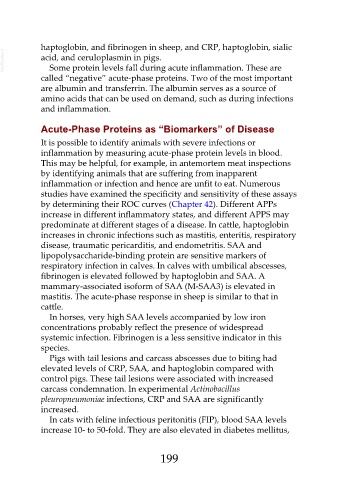Page 199 - Veterinary Immunology, 10th Edition
P. 199
haptoglobin, and fibrinogen in sheep, and CRP, haptoglobin, sialic
VetBooks.ir acid, and ceruloplasmin in pigs.
Some protein levels fall during acute inflammation. These are
called “negative” acute-phase proteins. Two of the most important
are albumin and transferrin. The albumin serves as a source of
amino acids that can be used on demand, such as during infections
and inflammation.
Acute-Phase Proteins as “Biomarkers” of Disease
It is possible to identify animals with severe infections or
inflammation by measuring acute-phase protein levels in blood.
This may be helpful, for example, in antemortem meat inspections
by identifying animals that are suffering from inapparent
inflammation or infection and hence are unfit to eat. Numerous
studies have examined the specificity and sensitivity of these assays
by determining their ROC curves (Chapter 42). Different APPs
increase in different inflammatory states, and different APPS may
predominate at different stages of a disease. In cattle, haptoglobin
increases in chronic infections such as mastitis, enteritis, respiratory
disease, traumatic pericarditis, and endometritis. SAA and
lipopolysaccharide-binding protein are sensitive markers of
respiratory infection in calves. In calves with umbilical abscesses,
fibrinogen is elevated followed by haptoglobin and SAA. A
mammary-associated isoform of SAA (M-SAA3) is elevated in
mastitis. The acute-phase response in sheep is similar to that in
cattle.
In horses, very high SAA levels accompanied by low iron
concentrations probably reflect the presence of widespread
systemic infection. Fibrinogen is a less sensitive indicator in this
species.
Pigs with tail lesions and carcass abscesses due to biting had
elevated levels of CRP, SAA, and haptoglobin compared with
control pigs. These tail lesions were associated with increased
carcass condemnation. In experimental Actinobacillus
pleuropneumoniae infections, CRP and SAA are significantly
increased.
In cats with feline infectious peritonitis (FIP), blood SAA levels
increase 10- to 50-fold. They are also elevated in diabetes mellitus,
199

